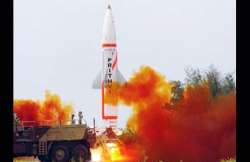India Test-Fires Prithvi-II, Dhanush Successfully
India on Saturday successfully testfired indigenously developed ballistic missiles 'Prithvi—II' and ‘Dhanush' from different locations off the Orissa coast, adding more firepower to the armed forces. “The tests were successful. Both the missiles testfired early

India on Saturday successfully testfired indigenously developed ballistic missiles 'Prithvi—II' and ‘Dhanush' from different locations off the Orissa coast, adding more firepower to the armed forces.
“The tests were successful. Both the missiles testfired early today met all the parameters,” the director of the Integrated Test Range (ITR) at Chandipur, S P Dash said.
While the ‘Prithvi-II' was testfired from complex-3 of ITR Chandipur, 15 km from here, from a mobile launcher at around 0548 hours, the ‘Dhanush' was fired from INS-Subhadra in the Bay of Bengal near Puri at around 0544 hours by the Navy personnel as part of user training exercise.
The test firing of the short-range, surface-to-surface 'Prithvi-II' ballistic missile having a range of 295 km, which has already been inducted into the armed forces, was a user trial by the Army.
The sleek missile is “handled by the strategic force command”, the sources said.
Prithvi, the first ballistic missile developed under the country's prestigious Integrated Guided Missile Development Programme (IGMDP), has the capability to carry 500 kg of warhead and has liquid propulsion twine engine.
With a nine-metre length and one-metre diameter, Prithvi-II uses an advanced inertial guidance system with manoeuvring trajectory and reach the targets with a few metre accuracy.
The entire trajectory of today's trial was tracked down by a battery of sophisticated radars and an electro-optic telemetry stations were positioned in different locations for post-launch analysis, defence sources said.
The nuclear-capable ‘Dhanush', the naval version of Prithvi, followed the pre-designated trajectory with text-book precision and two naval ships located near the target have tracked the splash, sources said.
The 350-km range missile will give the Navy the capability to attack enemy targets with great precision.
The sophisticated radar systems located along the coast monitored its entire trajectory, the sources said.
The single stage missile, weighing six tonnes, is powered by liquid propellants.
“The tests were successful. Both the missiles testfired early today met all the parameters,” the director of the Integrated Test Range (ITR) at Chandipur, S P Dash said.
While the ‘Prithvi-II' was testfired from complex-3 of ITR Chandipur, 15 km from here, from a mobile launcher at around 0548 hours, the ‘Dhanush' was fired from INS-Subhadra in the Bay of Bengal near Puri at around 0544 hours by the Navy personnel as part of user training exercise.
The test firing of the short-range, surface-to-surface 'Prithvi-II' ballistic missile having a range of 295 km, which has already been inducted into the armed forces, was a user trial by the Army.
The sleek missile is “handled by the strategic force command”, the sources said.
Prithvi, the first ballistic missile developed under the country's prestigious Integrated Guided Missile Development Programme (IGMDP), has the capability to carry 500 kg of warhead and has liquid propulsion twine engine.
With a nine-metre length and one-metre diameter, Prithvi-II uses an advanced inertial guidance system with manoeuvring trajectory and reach the targets with a few metre accuracy.
The entire trajectory of today's trial was tracked down by a battery of sophisticated radars and an electro-optic telemetry stations were positioned in different locations for post-launch analysis, defence sources said.
The nuclear-capable ‘Dhanush', the naval version of Prithvi, followed the pre-designated trajectory with text-book precision and two naval ships located near the target have tracked the splash, sources said.
The 350-km range missile will give the Navy the capability to attack enemy targets with great precision.
The sophisticated radar systems located along the coast monitored its entire trajectory, the sources said.
The single stage missile, weighing six tonnes, is powered by liquid propellants.